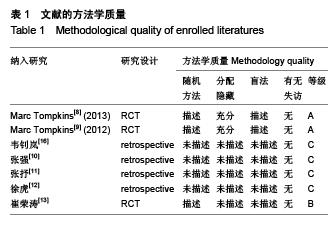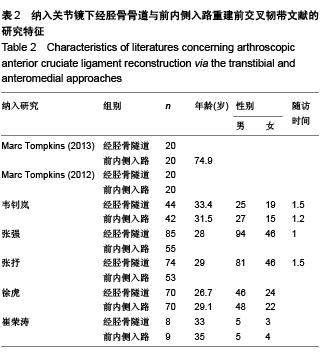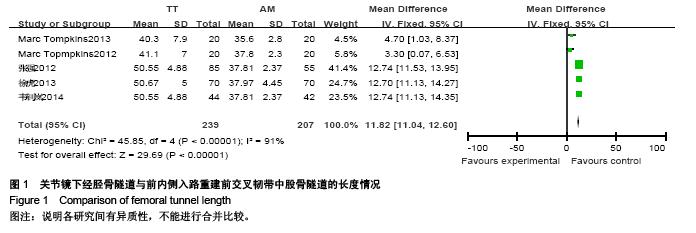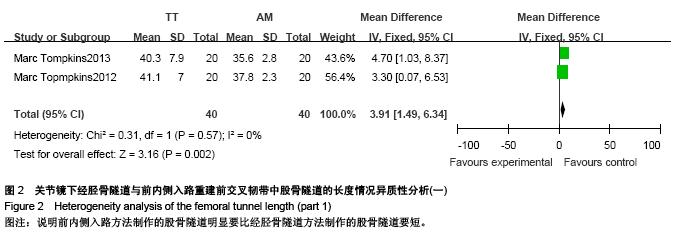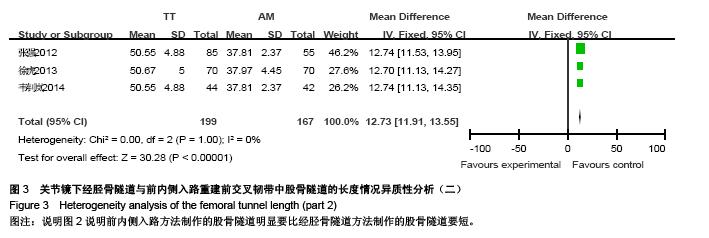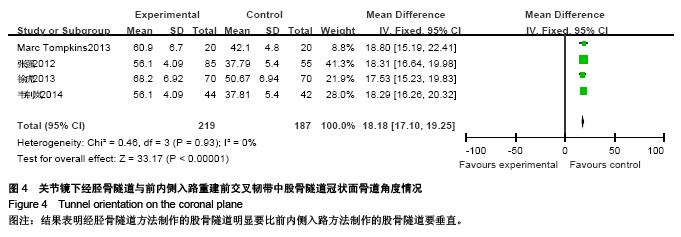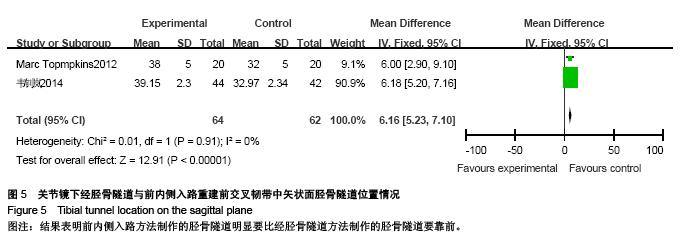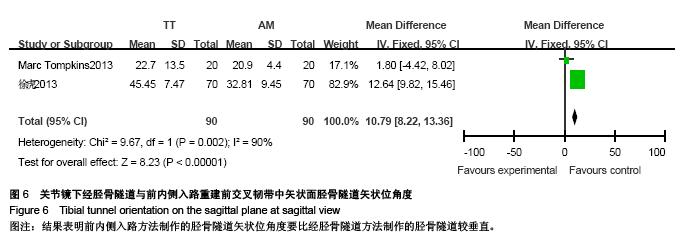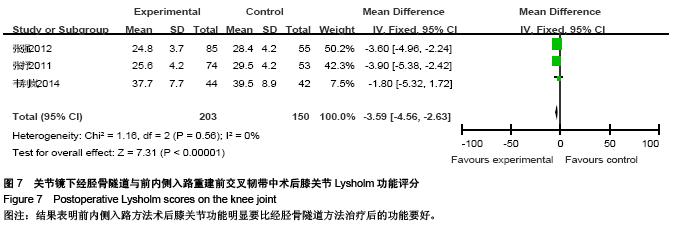| [1] Okazaki K, Miura H, Matsuda S, et al.Assessment of anterolateral rotatory instability in the anterior cruciate ligament-deficient knee using an open magnetic resonance imaging system. Am J Sports Med.2007;35(7): 1091-1097.
[2] Culvenor AG, Cook JL, Collins NJ,et al.Is patellofemoral joint osteoarthritis an under-recognised outcome of anterior cruciate ligament reconstruction? A narrative literature review. Br J Sports Med.2013;47(2): 66-70.
[3] Kopf S, Musahl V, Tashman S,et al. A systematic review of the femoral origin and tibial insertion morphology of the ACL. Knee Surg Sports Traumatol Arthrosc.2009;17(3): 213-219.
[4] Webster KE, Palazzolo SE, McClelland JA, et al. Tibial rotation during pivoting in anterior cruciate ligament reconstructed knees using a single bundle technique. Clin Biomech (Bristol, Avon). 2012;27(5): 480-484.
[5] 王磊,陈根元,王凤凤,等.扩髓与非扩髓髓内钉置入固定治疗成人闭合性胫骨干骨折的Meta分析[J].中国组织工程研究,2012, 16(17):3130-3133.
[6] 李建刚,王磊,董喆,等.髓内钉与钢板内固定治疗胫骨远端关节外骨折的Meta分析[J].中国组织工程研究,2013,17(48): 8361-8367.
[7] Alderson P, Green S, Higgins JPT. Cochrane Reviewers’ Handbook 4.2.2. In: The Cochrane Library. Chichester, UK: John Wiley & Sons, Ltd.2004.
[8] Tompkins M, Cosgrove CT, Milewski MD,et al.Anterior cruciate ligament reconstruction femoral tunnel characteristics using an accessory medial portal versus traditional transtibial drilling. Arthroscopy.2013;29(3): 550-555.
[9] Tompkins M, Milewski MD, Brockmeier SF, et al. Anatomic femoral tunnel drilling in anterior cruciate ligament reconstruction: use of an accessory medial portal versus traditional transtibial drilling. Am J Sports Med. 2012; 40(6): 1313-1321.
[10] 张强,张抒,李瑞,等.前交叉韧带单束重建中两种股骨隧道制备方法的疗效比较[J].中国矫形外科杂志,2012,20(20):1851-1853.
[11] 张抒,张强,李瑞,等.前交叉韧带重建术股骨隧道制作方式的临床研究[J].中华临床医师杂志:电子版,2011,5(17):5132-5134.
[12] 徐虎,张春礼,李光政等.前交叉韧带重建中两种建立股骨隧道方法的比较[J].中国矫形外科杂志,2013,21(8):746-750.
[13] 崔荣涛.三维CT重建技术评估AM和TT两种手术方式行前交叉韧带重建术后膝关节的运动水平[J].大连医科大学,2013.
[14] 韦钊岚,李富明,彭伟秋,等.关节镜下经胫骨骨道与前内侧入路重建前交叉韧带的比较研究[J].中国修复重建外科杂志, 2014, 28(3):339-344.
[15] Taketomi S, Nakagawa T, Takeda H, et al. Anatomical placement of double femoral tunnels in anterior cruciate ligament reconstruction: anteromedial tunnel first or posterolateral tunnel first. Knee Surg Sports Traumatol Arthrosc.2011;19(3): 424-431.
[16] Aglietti P,Giron F,Losco M,et al.Comparison between single-and double-bundle anterior cruciate ligament reconstruction: a prospective, randomized, single-blinded clinical trial.Am J Sports Med.2010;38(1): 25-34.
[17] 张鹏礼,王耀霆,贾一明,等.前交叉韧带重建术中经胫骨的股骨隧道足迹定位方法改进及术后骨道评估[J]. 武警医学,2012,23(5): 395-399.
[18] Tompkins M, Cosgrove CT, Milewski MD,et al. Anterior cruciate ligament reconstruction femoral tunnel characteristics using an accessory medial portal versus traditional transtibial drilling. Arthroscopy. 2013;29(3): 550-555.
[19] 沈光思,徐又佳,周海斌,等.前交叉韧带重建术股骨隧道角度与隧道壁承受应力关系的研究[J]. 临床骨科杂志,2008,11(5): 469-472.
[20] 宋恩鸿.股骨隧道角度对前交叉韧带重建术后骨隧道影响的实验研究[D].桂林医学院,2014.
[21] Bedi A, Musahl V, Steuber V, et al. Transtibial versus anteromedial portal reaming in anterior cruciate ligament reconstruction: an anatomic and biomechanical evaluation of surgical technique. Arthroscopy. 2011;27(3): 380-390.
[22] Okafor EC, Utturkar GM, Widmyer MR, et al. The effects of femoral graft placement on cartilage thickness after anterior cruciate ligament reconstruction. J Biomech. 2014;47(1): 96-101.
[23] 何天衢.股骨隧道定位点对前交叉韧带重建中移植物等距性影响的有限元分析[D].中南大学,2014.
[24] 邢基斯,冯宗权, 侯蕾,等. 胫骨骨道定位对前交叉韧带单束重建的影响[J].中国矫形外科杂志,2012,20(12): 1092-1096.
[25] Bedi A, Maak T, Musahl V, et al. Effect of tunnel position and graft size in single-bundle anterior cruciate ligament reconstruction: an evaluation of time-zero knee stability. Arthroscopy. 2011;27(11): 1543-1551.
[26] Sadoghi P, Kropfl A, Jansson V, et al. Impact of tibial and femoral tunnel position on clinical results after anterior cruciate ligament reconstruction. Arthroscopy. 2011;27(3): 355-364.
[27] Osti M, Krawinkel A, Ostermann M,et al. Femoral and Tibial Graft Tunnel Parameters After Transtibial, Anteromedial Portal, and Outside-In Single-Bundle Anterior Cruciate Ligament Reconstruction.Am J Sports Med.2015;43(9): 2250-2258.
[28] Bedi A, Musahl V, Steuber V, et al.Transtibial versus anteromedial portal reaming in anterior cruciate ligament reconstruction: an anatomic and biomechanical evaluation of surgical technique. Arthroscopy.2011;27(3): 380-390. |
